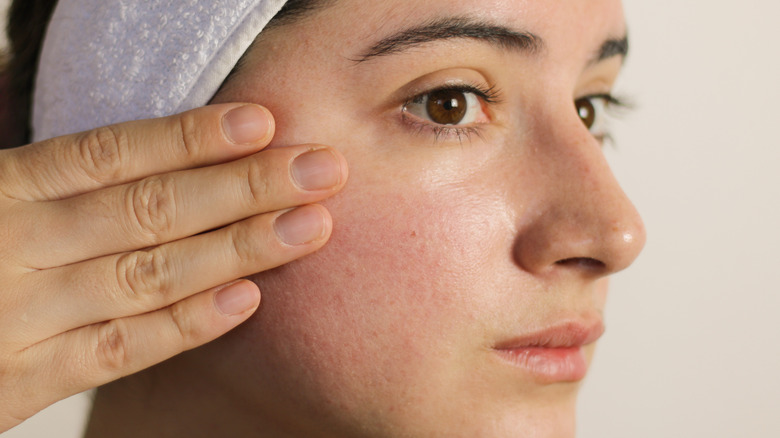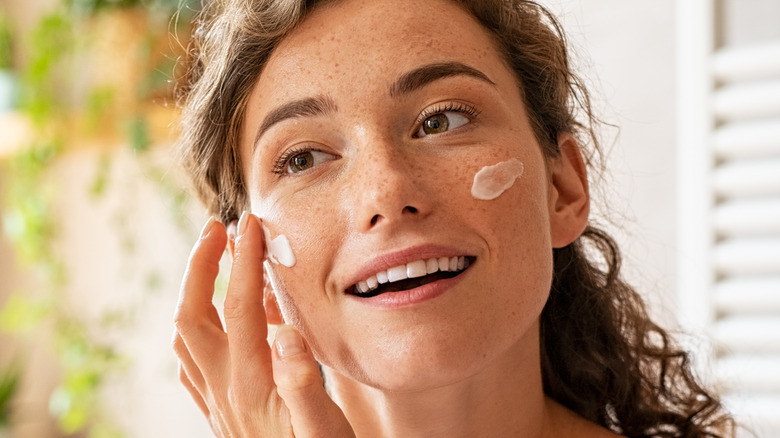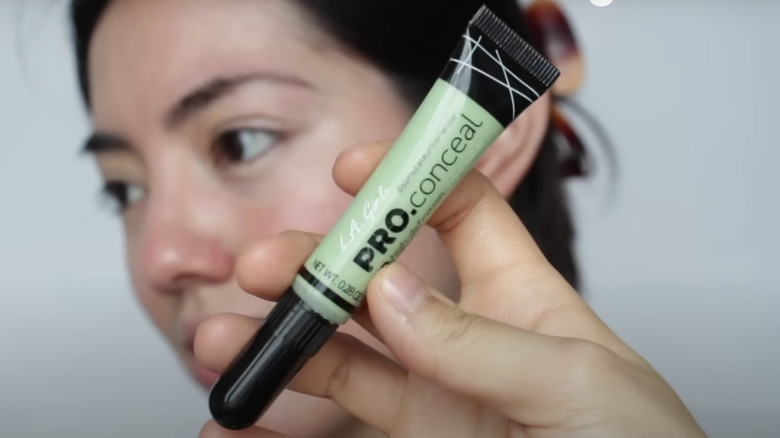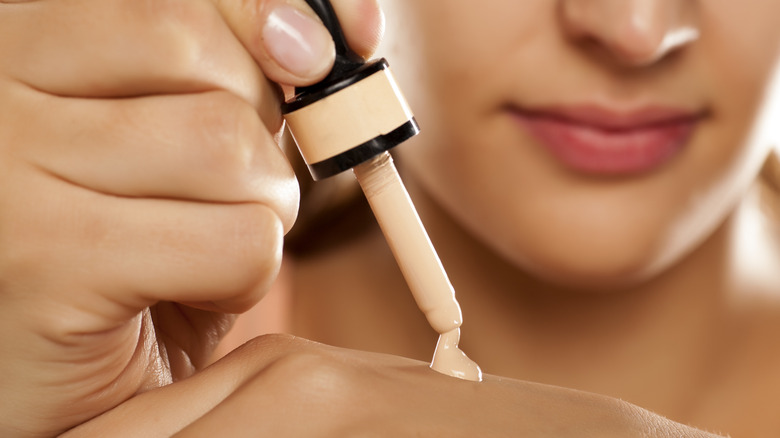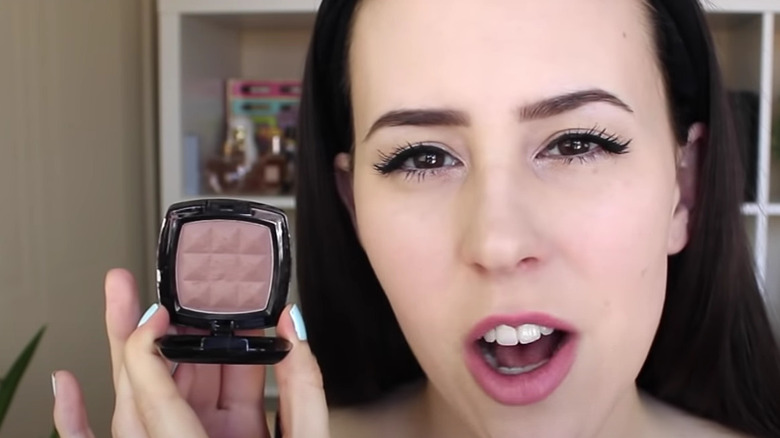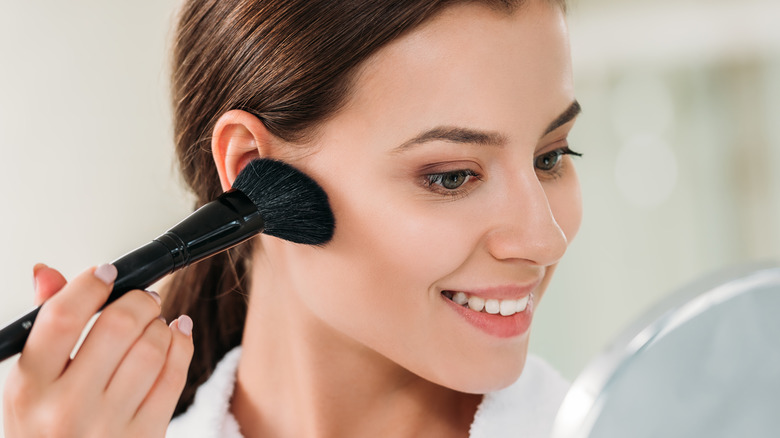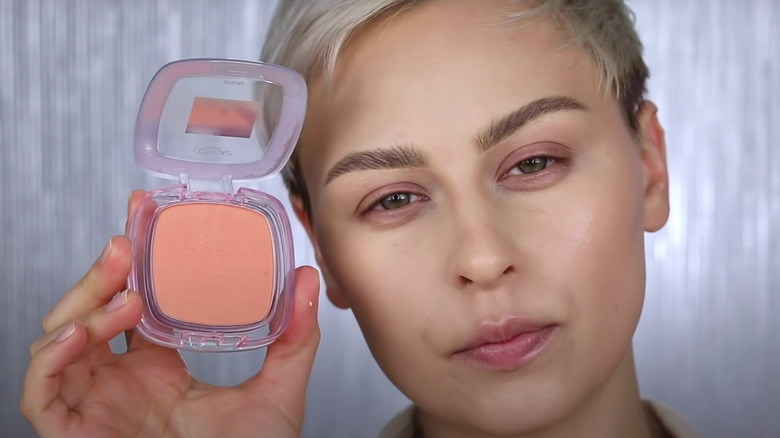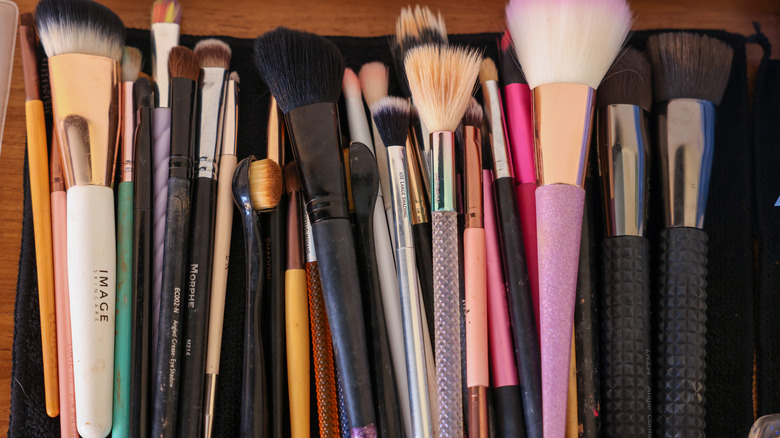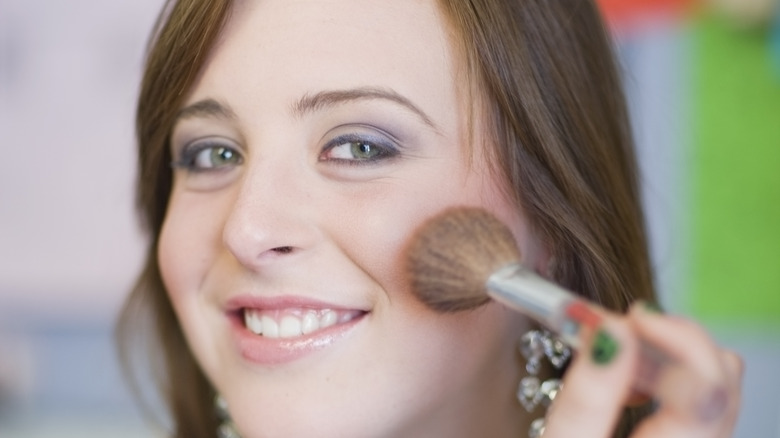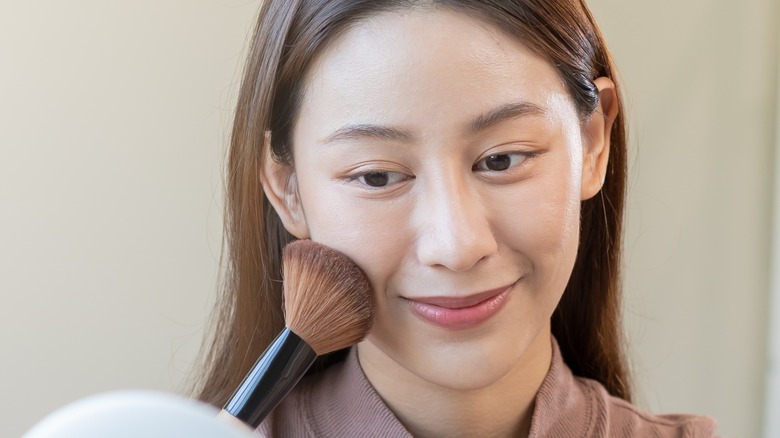Yes, You Can Still Wear Blush If You Have Rosacea. Here's How
Rosacea affects up to 16 million people in the U.S. alone, with women being more vulnerable than men, particularly during menopause. Suppose you have this common skin condition, which causes inflammation and redness on the face, especially across the nose and cheeks. In that case, you may be cautious about adding a dash of rosy color to your already reddened skin. However, it's actually straightforward to pull off wearing blush when you have rosacea. And you may even be able to camouflage the effects of the condition.
Naturally, there are some extra steps that you should take to make sure that you pull off the look correctly. But they are all easy to follow and may even already be a part of your regular skincare and makeup routine. However, these will all ensure that your look reaches its full potential. Below, we'll explain how to pull off a natural blush look with rosacea.
Hydrate your skin
First, you need to hydrate your skin, which you can do with products such as a tinted moisturizer or a hydrating serum. This first step is arguably one of the most important, as it helps to prepare your skin and set a good base to apply your blush. In addition, it may also help to combat any dryness that you experience, a symptom common among individuals with rosacea. Combating any dryness is vital to keeping your skin looking smooth and flawless.
Likewise, serums with hyaluronic acid may have a similar effect, helping to keep the skin moisturized throughout the day. Again, this will help you to combat any dryness on your face. Serums are a great option if you prefer a product that feels lighter on the skin compared to a heavier moisturizer. If you have other hydrating products that you already know work well with your skin, feel free to use those too.
Use color corrector on flare-ups
This step is optional — but it's always good to have it in your arsenal should you need it. If you want to reduce any redness further, try a color-correcting primer or moisturizer that has a green tint. The two colors neutralize each other because red and green are positioned on opposite ends of the color wheel. Just like with your regular moisturizer and primers, apply it before your foundation and wait 15 minutes. Some green-tinted products even contain hyaluronic acid, which means your skin may receive an extra boost of hydration.
"Once the skin is neutralized, it's easier to have a wider range of blushes to choose from," makeup artist Fiona Stiles told Allure. If you're unsure about what color-correcting product will work best for your skin, Stiles recommends a formula that is thinner in consistency, which will allow your makeup to sit smoothly on your skin.
Move on to concealer or foundation
Once your skin is hydrated and primed, you can build the rest of your base. The next step of the process is to apply a foundation or concealer. It would be best if you aimed for a full coverage foundation, as it will help tone down the rosacea's redness and give your blush a perfect canvas to sit on. However, if you're not a fan of foundation, a light touch of concealer will suffice. "Even if you're not using a foundation, I do think that just toning down the rosacea would be helpful with just a couple of swipes of concealer, as this way the blush can live on your skin without competing with the natural redness in your complexion," makeup artist Allan Avandaño told Allure.
This order of application — hydrate, prime and color-correct, and finally, add a base layer — is important to create a more natural, flawless look that will last much longer. Using the foundation as a base will allow the blush to sit on top of the skin, rather than be absorbed into it, resulting in it looking patchy.
Choose a color that will counteract redness
On to selecting the correct blush color. This step is very important, as the wrong color may be too harsh and uncomplimentary to your skin and exacerbate any redness you are experiencing. So, what blush color is best suited for individuals with rosacea? As a general rule of thumb, Chanel makeup artist Zoë Taylor told PopSugar she recommends "going for blushers that have a more taupe or peachy undertone."
Taupe is a mix of brown and grey — quite the contrast to brighter, more typical blush colors such as red, rosy pink, and mauve. But those muted tones are exactly what makes it a much more suitable option. Similarly, soft coral shades are also a great alternative for the same reasons, but this color may be more appealing if you decide you do want to add a small pop of color to your look.
These blush shades are perfect for individuals with rosacea, as they help counter any redness you may have. Using them will help your final look be as natural as possible.
Try bronzer as an alternative
Alongside peachy and taupe shades, bronze blush shades can also work well for individuals with rosacea. Again, this is because the color works well to mute any redness.
To get the best finish that will compliment your skin, makeup artist Robin Black recommends opting for a bronzer with golden undertones. "I apply a sheer foundation or a little bit of concealer to neutralize the redness but not cover it completely, and then I use a powder bronzer that is paler in shade with a golden undertone over the cheeks," she told Allure. "The natural red from the rosacea comes through, and together, they create a gorgeous glowing cheek that mimics the look of a day at the beach."
So, while you may have never considered using a bronzer before, it's something you could experiment and play around with. If you decide that you want to work with a bronzer, the application process is still the same. You should always apply your base foundation layer before applying your bronzer on top.
Powder versus cream blush
Choosing the correct blush color is vital when working with rosacea, but what about the formula? Should you stick with powder, or is it better to use a cream blush? While one may presume that one formulation works better than another, it actually boils down to personal preference, the type of makeup you are wearing with it, and your skin type. Depending on these factors, both options can be equally as effective, but it is important to note that powder may be less friendly on drier skin types. In contrast, cream formulas are usually more hydrating on the skin.
Another thing to keep in mind when choosing the best blush for you if you have rosacea is to ensure that your product only contains ingredients that are gentle on your skin. For this reason, it's always worth doing some extra research into ingredients to note any irritants that could potentially make your skin flare up. Products with fragrance are often a common culprit when it comes to irritated skin, so opt for fragrance-free blush formulas whenever you can.
Choose the right application tool
While choosing the right blush color is essential, so is using the right tool to do the job. Doing so will help you to achieve the perfect finish when applying your blush and allow you to apply just the right amount of product, which is important when working with rosacea. So, which brush is better – synthetic versus natural? The answer varies depending on what type of blush you're using.
If you opt for a cream blush, then a synthetic brush is best for application, as more of the product will transfer onto your skin. This is because synthetic brushes won't soak up as much product. The opposite is true of natural hair brushes, of course, making them a perfect option for powder blushes.
You should also consider brush size. When it comes to applying blush, you should aim for the brush size to be slightly smaller than the apples of your cheeks. This will allow you to achieve the perfect finish and prevent you from applying too much product to your skin.
Apply blush gently
Now you know what blush and brush to use, you should be primed and ready to apply your chosen product. For a natural, glowing look, gently apply your bronzer or blush to the apples of your cheeks and blend outward. Applying blush along your cheekbones is another great way to add interest to your overall look. Makeup artist Zoë Taylor told PopSugar that the technique adds "natural contouring."
During this stage of the process, you should take extra care not to be rough when you apply the blush. The key is to be gentle so as not to aggravate your skin further. If you apply the blush correctly, you should be left with a very natural-looking result, with the slight pigment from the rosacea amplifying the look. However, don't worry if you don't get this right the first time — it can take a lot of trial and error before finally getting it to the standard you want.
Build up, if needed
You now know to be gentle when applying blush, but how much of the product should you actually use? It can be tricky to know the answer to this part. However, there is a simple solution. As your cheeks are already naturally flushed, it is best to apply a small amount of blush to start so that you can see how it looks. Afterward, if you feel as though more is necessary, you can build up the layers from there. If you apply too much at once, you may end up overdoing it, and the look will be ruined.
When you're about to apply your blush, find a spot filled with plenty of light — preferably natural light. Doing so will allow you to have the lightest hand as you will see clearly how much blush you are using.
If you do end up in a situation where you think you have overapplied your blush, you risk irritating your skin if you clean the makeup completely off to start again. So, try dabbing the area with a small amount of concealer or foundation. This way, your blush won't be as overwhelming, and you can try to apply it again.
